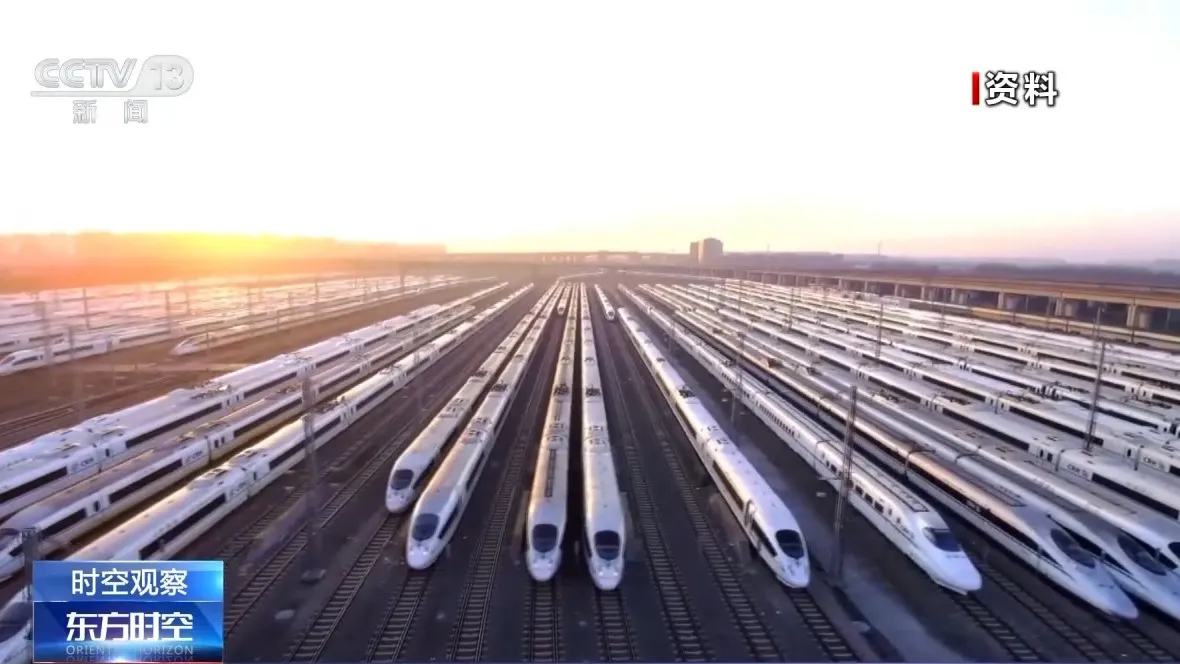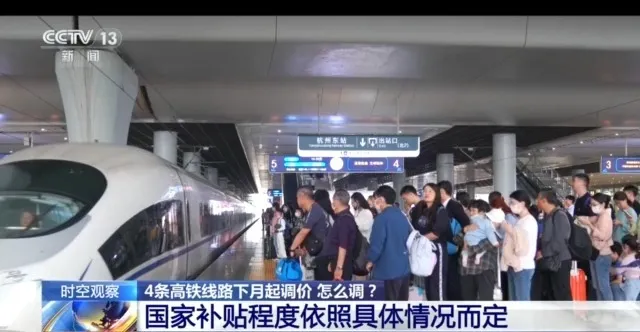How is high-speed rail priced? What are the considerations for fare adjustment? Expert interpretation
Recently, news about fare adjustments on several popular high-speed rail lines has attracted more attention. Many people have discovered that fares on some lines will increase to varying degrees, with some increases reaching around 20%.
On May 2, the official website of Railway 12306 issued four price adjustment announcements. The announcement shows that starting from June 15 this year, the EMU trains running at speeds of 300 kilometers per hour and above on the Beijing-Guangzhou High-speed Railway, the Shanghai-Hangzhou Section of the Shanghai-Kunming High-speed Railway, the Hangzhou-Changchun Section of the Shanghai-Kunming High-speed Railway, and the Hangzhou-Ningbo Section of the Hangzhou-Shenzhen Railway will be announced. Fares, that is, full-price tickets without discounts, are optimized and adjusted.
Judging from the published fare list, some adjusted published fares have increased compared to the current fares. Taking the Wuhan-Guangzhou section of the Beijing-Guangzhou High-Speed Railway as an example, the second-class ticket price from Changsha to Guangzhou South will be 377 yuan from June 15, 2024, an increase of 20.06% from the current published fare of 314 yuan.
Another example is the Shanghai-Kunming High-Speed Railway's Shanghai-Hangzhou section. The published fare for the second-class seat from Shanghai Hongqiao to Hangzhou East has been increased to 87 yuan, an increase of 19.18% from the current published fare of 73 yuan.
In the announcement, the railway company also stated that the fares implemented between stations will be based on the published fare as the upper limit and 55% off as the lower limit, and implement a multi-level, flexible discount floating fare system to provide passengers with more choices for travel.
How is high-speed rail priced? Before 2016, it was centrally managed by the state and was mainly calculated and formulated based on construction and operating costs.

In 2007, the former Ministry of Railways issued a notice clearly stipulating that the base price of soft-seat fares for EMU trains is 0.3366 yuan per kilometer for first-class seats and 0.2805 yuan for second-class seats, which can fluctuate by 10%. The pricing of high-speed rail refers to the pricing of EMUs, and also takes into account factors such as construction costs and market demand. The fares of high-speed rails are generally higher than the fares of ordinary EMUs. In addition, high-speed rail pricing follows the principle of decreasing distance, that is, the longer the mileage, the lower the average freight rate. In February 2016, the National Development and Reform Commission issued the "Notice on Reforming and Improving Passenger Fare Policies for High-Speed Rail EMUs", allowing railway transportation companies to independently price high-speed rail EMU passenger tickets.
So what are the main considerations for adjusting high-speed rail fares? Why were these lines chosen for adjustment this time? Let’s hear what the experts have to say.
Li Hongchang, a researcher at the Sustainable Transportation Innovation Center and deputy dean of the School of Economics and Management at Beijing Jiaotong University: The adjustment of high-speed rail fares must consider the impact of comprehensive factors such as high-speed rail market demand, high-speed rail transportation supply capacity, the financial balance of the railway system, and market competition.
From the perspective of high-speed rail market demand, any line with relatively strong market demand, a relatively high proportion of business passengers, and a strong passenger payment ability can adopt more flexible and diverse fare systems.
From the perspective of high-speed rail transportation supply capacity, for lines with relatively tight high-speed rail supply capacity, especially busy trunk lines such as Beijing-Shanghai, Beijing-Guangzhou, and Beijing-Harbin, in order to better allocate the scarce transportation capacity of the railways, it is also necessary to pass the ticket Allocate transportation capacity by pricing fares. The allocation of transportation capacity is not only a process of allocation for passengers, but also a process of allocation of the capabilities of different railway transport enterprises within the railway.
The rail system's ability to financially balance. Railways are facing tremendous pressure to repay debt and interest. Through ticket system fares, the overall revenue of the railway can be continuously increased. This can form a balancing and restricting mechanism for the railway's financial balance.

It is necessary to consider the market competition factors of railways, especially the competition faced by railways from civil aviation highways and other transportation modes. To adapt to the development needs of the comprehensive transportation system, it also needs to be adjusted through ticket system fares.
Based on the above reasons, this is also an important reason for choosing these routes. The market demand for Changchun-Dalian trunk line is strong, and the supply capacity of high-speed rail is relatively tight. The railway transportation system has strong financial compensation capabilities and relatively fierce market competition, so such a flexible fare system can be adopted.
Railway transportation is different from road transportation and air transportation. The state investment is quite large, and the distribution of profitable lines is also very uneven due to the influence of regional economy. The recent rapid growth in passenger traffic has also brought benefits to railways in terms of revenue and profits.
In recent times, railway passenger traffic has repeatedly broken historical records. In 2023, the China Railway Group will carry 3.68 billion passengers, more than double the year-on-year increase. During the May Day holiday that just passed, the single-day passenger volume of railways continued to remain above 16 million. On May 1, the volume reached 20.691 million, setting a record high for single-day passenger volume.
Just on April 30, China Railway Group released its 2023 financial final accounts. In 2023, China Railway Group achieved operating income of 1,245.4 billion yuan, a year-on-year increase of 10.5%, and net profit of 3.3 billion yuan, exceeding the 3 billion yuan mark for the first time.
So what is the current situation of high-speed rail operations and state subsidies in different regions of my country? In the long term, what will happen to high-speed rail fares?

Li Hongchang, a researcher at the Sustainable Transportation Innovation Center and deputy dean of the School of Economics and Management at Beijing Jiaotong University: Because railways have a very strong public welfare nature, national financial subsidies are a normal issue, which is a common trend at home and abroad. As far as high-speed railways are concerned, if we consider a four-vertical and four-horizontal high-speed railway network, the amount of state subsidies will definitely decline and decrease. If we consider the eight-vertical and eight-horizontal high-speed rail network, as the public welfare level of high-speed rail projects continues to improve, then under the debt development model, state subsidies will continue to increase. However, railway cargo transportation and the four-vertical and four-horizontal high-speed rail network are highly profitable and can be cross-subsidised within the railway, thus reducing the amount and level of national subsidies as a whole.
Generally speaking, high-speed rail connecting major urban agglomerations in my country are more likely to be profitable due to relatively strong actual or potential passenger flow demand. China's current Beijing-Shanghai high-speed railway, Beijing-Tianjin intercity railway, and Beijing-Guangzhou high-speed railway all have the actual ability to make profits. For other high-speed rail lines connecting my country's major urban agglomerations and regional urban agglomerations, as my country's income level continues to increase and passenger flow continues to be cultivated, they will also have the ability to make profits in the future.
The continuous marketization of high-speed rail ticket prices is a basic trend. There will be a trend of rising and falling prices for high-speed rail, which is an inherent need for high-speed rail revenue management. Due to the continuous increase in costs, raw materials, power, etc., under cost-driven conditions, the adjustment of high-speed rail fares is also a long-term development trend. Of course, in the reality of our country, during the development of railways, there is an inherent background of relying heavily on debt financing for development, which also puts an inherent pressure on the cost of repaying principal and interest.




